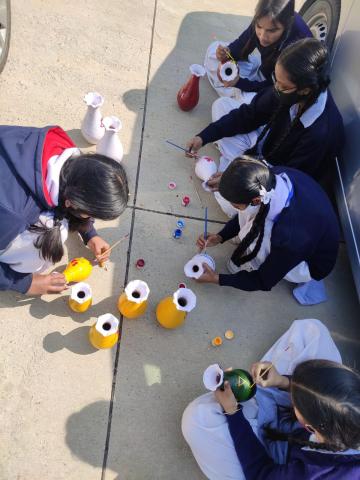
Creating a diverse school culture
A tourist bus passes through the streets of a wonderland. Tourists peek out of the windows and utter…
“Look, Look…Those trees are like the trees found in our country”
“Hey, I saw a symbol that we worship”
“I found a poster in our language, surprising? Do these people understand our language?
“Hey look at that poster…it’s the same actor which we celebrate in our country”
“Wohooo, I found my favourite food restaurant on the other side of the road”
Michael Apple in his book, “Ideology and Curriculum” explains a very interesting phenomenon of how culture plays an extremely interesting role in determining the educational outcome of an individual or a group. Cultural capital also tends to help one earn more like economic capital.
In day-to-day school experience, we encounter this and in a simplified version, we understand cultural capital as the environment of a child. Some children inherit a rich culture and thus it becomes easier for them to get connected with the phenomena of the school. Hammerlsy describes it in the book “Researching School Experience”.
Can culture be created?
To begin with, we have to acknowledge these principles of the sociology of education. Learning in schools is mostly based on the principles of psychology; at a particular age, a child should be in a particular grade; he/she should achieve a particular learning outcome. In the managerial system, this may look attractive, but in the school system, which has the responsibility of reaching out to poor children, sociological principles must also be taken into account. Otherwise, we will continue to push children out of the school
‘We can’t create culture’…but we can value the culture a child carries to the school
We can’t create the culture overnight, but we can value the culture a child carries with him/her. Most mainstream schools try to impose middle-class values on children. Farah, in her book “Ek school manager ki diary” has explained it strikingly. She brings the example of how middle-class values are imposed on the working class children. Children from working class backgrounds often find it difficult to cope with middle class values, she explains. This is also about the dominance of a value system. But, in reality, it deeply hampers the learning opportunity for the children. On one hand, we deeply appreciate the provision of a ramp for the differently-abled person, on the other hand, we ignore the representation of the cultural norms and values of children in our school. If we visualize it...for children whose cultural values are not reflected in the school, learning is as challenging to them as it is for a differently-abled child to climb stairs. A child, when entering the school, finds no representation of their cultural values and norms, feels disabled. Their motivation to learn gets deeply paralysed.
What can we do?
We need to understand the broader meaning of inclusive classrooms, where inclusion is not just about physical ailments, but also about linguistic, religious, and other cultural values. It is extremely important to make students feel that their language, culture and beliefs are important and valued. Schools may choose to display relevant symbols of cultural representations in the school. But, the most important is the disposition of teachers; how they speak about diversity matters the most! If teachers give examples which often represent one set of cultures and ignore others, students may find it difficult to adjust in such classrooms. Teachers need to include examples where every student has a chance to be represented. Teachers don’t exclude deliberately, but inclusion has to be deliberate.
Here, we take the example of linguistic diversity. Almost every classroom is a multilingual classroom. Particularly in places like Delhi, we find a pan-Indian representation of languages in our classrooms. Teachers can survey the classrooms to know the kind of language children know, speak and write. Once a teacher is aware of the linguistic diversity of the classroom, she can make a special effort to accommodate the languages which otherwise are not spoken in the classroom. Several approaches may be taken to accomplish this; a teacher may ask a student to tell a word in his/her language, a teacher may mention a famous person who speaks that language, or a teacher may mention a film, story, player, etc. Children speaking a particular set of languages will be able to relate to the classroom processes. Often, it is mistaken as the work of the language teacher. However, even math teachers need to do this.
Otherwise, we foster an environment which leads to silencing and ultimately it pushes out the students from the process of schooling.
Can we design a school environment where our students murmur…
“Hey, he is interested in knowing my language”
“I found a friend with whom I can play the game I used to play in my village”
“That poster on the wall, everybody knows him/her in my area”
“I can read this slogan…This is written in Telgu”
My school canteen offers my favourite food, I thought, in the city, I won’t be able to have it.
You can keep adding to the list until you create a culture in your school that gives each student a sense of belonging.
- Log in to post comments
